Why Good UX Design is Essential for E-Commerce

We hear the term user experience, or UX, if you will, a lot. But when we look at the bigger picture, we see that it doesn’t take place in the list of priorities for many businesses and enterprises. On the other hand, there are countless reasons why the term is continuously becoming more and more popular. Especially in e-commerce, we see the trend that user experience takes a more viable position—in some cases; the experience brands offer their customers becomes even more essential than the product they are selling.
According to Amazon Web Services, 88% of customers say that they won’t likely visit a website again after having a bad user experience.
That’s only the tip of the iceberg when it comes to the essentiality of a good user experience. This blog post will dive deep into UX design in e-commerce, UX design principles, and UX design tools that will make the design process so much easier and convenient for your e-commerce front.
First things first: What is UX design?
Although you can get the essence of the definition of user experience (UX) design by its name, it can be interpreted in many different ways for different design principles of various branches of businesses. But in short, user experience design aims to offer the most suitable product/website/app experience for the end-user. Although every user might have a unique way of interacting with the interface, there are proven ways to create the best user experience design that makes the user experience feel intuitive.
As a SaaS company that focuses on every side of e-commerce, we’ve tested the best UX design cases with our platforms with user-centricity in mind. In the following sections, we’ll share our know-how on user experience design and how anybody in e-commerce can reach the highest UX scores.
E-commerce UX design principles
A mindful UX designer needs to answer three questions before beginning the UX design process:
What motivates users to use this product?
It may seem like almost every e-commerce website/app works more or less the same, but actually, every brand has a starting point that makes them stand out in some way. So, before beginning, shaping the experience around the idea is essential in satisfying the client and the end-users. In the end, there are tons of e-commerce sites, but the ones that can leave traces in the users’ minds are the ones that are remembered.
Which design elements are essential for an e-commerce service?
Of course, e-commerce is a two-decades-plus area, and it has its own set of rules & essentials, and your UX design process shouldn’t land too far from the basics while trying to stand out.
Here are best UX design practices for e-commerce:
Keep it simple:
E-commerce needs to be as quick a process as possible by nature, and loading your user interface with too much information will only come with consequences.
 Source: TechTarget
Source: TechTarget
Hick’s law is an excellent example of the choice/time equation. According to Hick’s law, the more choices there are, the longer it takes a person to reach the finishing line, a.k.a. the checkout screen in e-commerce websites or apps.
Work for the search bar
You may say “duh” for this one, but go to a run-of-the-mill e-commerce site and type something basic like “blue scarf”. Generally, the results are terrible when we look at the user’s perspective. The search feature may seem super-elementary, but building it the way it serves the consumer’s best interest can be really challenging. Set up a healthy tag system and take advantage of AI if you can before getting into picking the perfect search tool. In the end, Google is still a search engine; get inspired!
Visuals are your best friends
Images and videos are the display window of an e-commerce site or app. Like in brick-and-mortar stores, following a visual language that fits the essence of the brand and the interface will create a better, higher-quality brand image. For example, if you’re taking the minimalistic approach in your UX design process, you may choose transparent backgrounds for images that make them blend with the site/app interface.
Buy later, a.k.a. favourites
Giving the customers a list of favourites is one of the new trends, and it works perfectly. According to Statista, approximately 88% of shoppers abandon shopping carts, and another research shows that 54% of customers are likely to purchase items that they left in shopping cars later, especially if prices go down. A favourites page will also give your/your clients’ brand a new way to reach customers to remind them about special coupons and discounts. It’s one of the easiest user experience enhancement tricks, and the best part is, it’s pretty easy to implement.
How can you create a more streamlined and convenient user experience?
A good UX design in e-commerce doesn’t end with the essentials; it also requires an uninterrupted customer journey, a personalised shopping experience, and of course, a sense of security in the payment process. Here’s why these three UX design steps are essential to create a better shopping experience.
Be quick or be dead: Optimisation in e-commerce
The internet revolution accelerated our lives so fast that even a two-second wait has become unbearable. According to Google, the bounce rate increases by 123% if a page takes more than one second to load, and the same rules apply to e-commerce.
Google says a landing page takes about seven seconds to load, which is way too long for the regular user, and Google itself shares the simple page optimisations to make it faster—why not take advantage of it?
Of course, another part of optimisation is about mobile devices. More than half of organic search traffic comes from mobile devices, and expectedly, the numbers are only rising. On the e-commerce front, mobile takes an even more essential part with impulse shoppers and m-commerce apps. So, although it may not seem like the problem of the UX designer, doing your part of the optimisation is incredibly essential.
Personalise the user experience
Personalisation is one of the hot topics of the digital world, and it’s all about the user journey. We see big names like Amazon and Chewy take advantage of personalised landing page designs with the help of user recognition. It might have been a challenging concept a couple of years ago, but it’s all about data collection and making the proper implementations. The good part is, today’s consumer is more mindful about sharing their personal data.
EY’s research says that 51% of customers trust in the companies collecting personal data, and Accenture’s 2018 research shows that 91% of customers are more likely to buy more from brands that give them personalised recommendations.
So, while designing the process, giving the sense of credibility and a good user experience in return of data collection is a must.
Simplify the checkout process
Users need to know where the exit is, so placing a floatable checkout button is the best way to go in e-commerce UX design. When they come to the checkout screen, customers like to see a simple screen that makes them feel safe. Another conversion increasing point is to allow guest checkout.
According to Monday.com, cart abandonment rises by 35% if an e-commerce site demands users to sign up or log in.
So, designing a simple and secure checkout process is essential for e-commerce UX design—your checkout screen should feel just like in a physical store.
Get the best in e-commerce UX design with Tmob
As a SaaS and PaaS company that has experience of more than a decade in the e-commerce area, we always took UX design seriously across all of our platforms and modules. In years and tons of scenarios, we managed to develop our design studio in a way that brings out the best for e-commerce businesses of any kind.
With Tmob Studio, you can create the most streamlined e-commerce experience for users that’ll carry your business on a whole new level in terms of conversion, loyalty, and retention.
Who are we?
Tmob | Thinks Mobility is a global technology powerhouse, specialized in digitalization and integration solutions, bringing growth and success to businesses and partners with its innovative SaaS, PaaS, and premium solutions since 2009 with Tmob Turkiye (TR) and Tmob United Kingdom (UK) headquarters.
Sources: 1- https://s3.amazonaws.com/coach-courses-us/public/theuxschool/uploads/The_Trillion_Dollar_UX_Problem.pdf 2- https://whatis.techtarget.com/definition/Hicks-law 3- https://www.statista.com/statistics/457078/category-cart-abandonment-rate-worldwide/#:~:text=In%20March%202020%2C%2088.05%20percent,an%2096.88%20percent%20abandonment%20rate 4- https://neilpatel.com/blog/5-ecommerce-stats/ 5- https://www.thinkwithgoogle.com/marketing-strategies/app-and-mobile/mobile-page-speed-new-industry-benchmarks-load-time-vs-bounce/ 6- https://www.statista.com/statistics/297137/mobile-share-of-us-organic-search-engine-visits/ 7- https://www.ey.com/en_ca/news/2021/01/50-percent-of-consumers-willing-to-share-more-personal-data 8- https://www.accenture.com/_acnmedia/PDF-77/Accenture-Pulse-Survey.pdf 9- https://wearemonday.medium.com/diving-deeper-in-e-commerce-guest-checkout-vs-customer-accounts-c35e4bbd0d68



